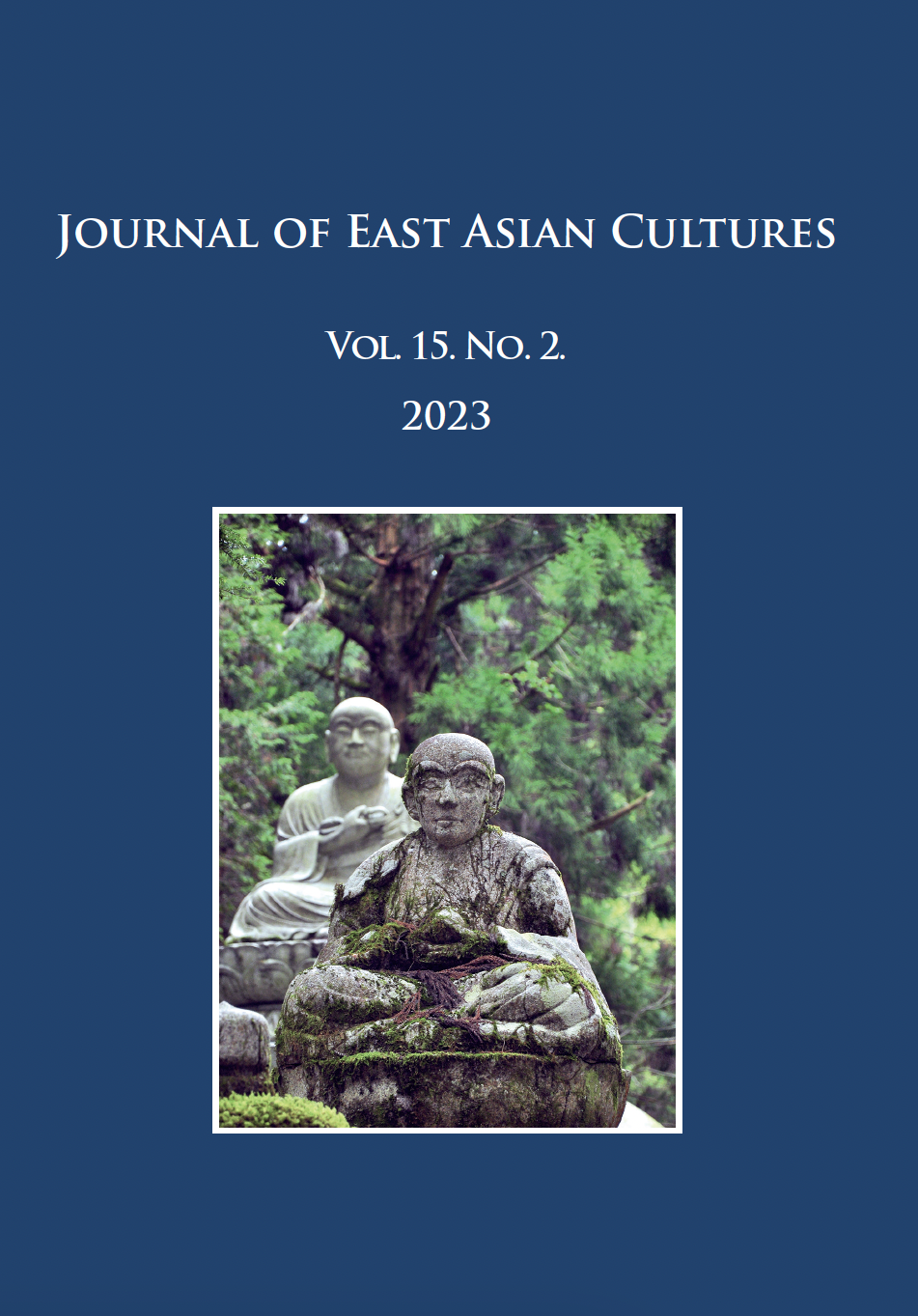On the Listening to Buddha’s Words with Reverence: The Very First Step of Buddhist Practice in Vasubandhu’s Vyākhyāyukti
Megjelent 2023-09-30
Kulcsszavak
- Vaszubandhu,
- Vjákhjájukti,
- Guṇamati,
- Vjákhjájuktiká,
- Pratítjaszamutpádavjákhjá
- Arthavistara,
- tisztelettel hallgatás,
- járomedény-hasonlat ...Tovább
Hogyan kell idézni

This work is licensed under a Creative Commons Attribution-NonCommercial 4.0 International License.
Absztrakt
This paper focuses on the fifth chapter of the Vyākhyāyukti by Vasubandhu, a Buddhist thinker who was active in the fourth and fifth centuries in Northwestern India, and a commentary on that work, the Vyākhyāyuktiṭīkā by Guṇamati. In this chapter, Vasubandhu deals with the issue of how those who preach about the Buddha’s words should teach about them and how those who listen to those teachings should study them. Vasubandhu explains that ‘listening to the Buddha’s words with reverence’ is critical as the first step of Buddhist practice.
The source for this position of Vasubandhu’s can be found in the Arthavistara-dharmaparyāya in the Dīrghāgama of the Sarvāstivāda. Vasubandhu argues that the first step of Buddhist practice is listening to the Buddha’s words with reverence based on the third of sixteen methods for listening to the Buddha’s words that are described in the fifth section of that scripture.
Why is reverence necessary when listening to the Buddha’s words? Vasubandhu uses the famous metaphor of three kinds of vessels in answering this question. This metaphor respectively likens (1) a person who does not listen to the teachings, (2) a person who listens to the teachings but misunderstands them, and (3) a person who listens to the teachings but fails to remember them to (1) an upside-down vessel, (2) a dirty vessel, and (3) a vessel with a hole in it. That is to say, Vasubandhu is pointing to the fact that if a listener lacks respect for the preacher, they will (1) not try to listen carefully to the teachings, (2) misunderstand them, or (3) forget them.
Vasubandhu also uses this metaphor in his Pratītyasamutpādavyākhyā, which was written after the Vyākhyāyukti. This metaphor also appears frequently in Tibetan Buddhist literature in the works of figures such as Bu ston rin chen grub and Tsong kha pa. The position that Vasubandhu took regarding the importance of listening to the Buddha’s words with reverence was extremely influential and came to be broadly held in the Buddhist traditions of both India and Tibet after the fifth century.
Hivatkozások
- AK Abhidharmakośakārikā (Vasubandhu): See AKBh.
- AKBh Abhidharmakośabhāṣya (Vasubandhu): P. Pradhan, ed., Abhidharmakośa- bhāṣyam of Vasubandhu. Patna: Kashi Prasad Jayaswal Research Institute, 1967.
- AvDh Arthavistara-dharmaparyāya. See Hartmann 1991.
- AvDh(tib.) The Tibetan translations of the Arthavistara-dharmaparyāya.
- See Hartmann 1991.
- AVSN Arthaviniścayasūtranibandhana (Vīryaśrīdatta): N.H. Samtani, ed., The Arthaviniścaya-Sūtra and Its Commentary (Nibandhana). Patna: Kashi Prasad Jayaswal Research Institute, 1971.
- Bhaiṣaj Bhaiṣajyavastu. Nalinaksha Dutt, ed., Gilgit Manuscripts, vol. III, Part 1.
- Calcutta: Calcutta Oriental Press, 1947.
- BoBh Bodhisattvabhūmi. Wogihara Unrai, ed., Bodhisattvabhūmi. Tokyo: 1930–1936.
- BU Bu ston chos 'byung (Bu ston rin chen grub): Tibetan Works Research Project ed., Bu ston’s Introduction to Buddhism: A Critical Edition of First Chapter of the Bu ston chos 'byung. Kyoto: Ōtani University Shin Buddhist Comprehensive Research Institute, 2022.
- D Derge (sDe dge) blockprint edition of the Tibetan Tripiṭaka.
- EĀ(Trip) Ekottarikāgama. Chandrabhal Tripathi ed., Ekottarāgama Fragmente der Gilgit-Handschrift. Reinbek: Dr. Inge Wezler Verlag für Orientalistische Fachpublicationen, 1995.
- P Peking edition of the Tibetan Tripiṭaka held at Otani University, Kyoto.
- PSVy Pratītyasamutpādavyākhyā (Vasubandhu): Giuseppe Tucci, ‘Fragment from the Pratītyasamutpādavyākhyā of Vasubandhu,’ Journal of Royal Asiatic Society 1930: 611–630. (Reprint: Opera Minora, parte I. Roma 1971, 277–304.)
- PSVy(tib.) The Tibetan translations of the Pratītyasamutpādavyākhyā. D 3995,
- P 5496.
- VyY Vyākhyāyukti (Vasubandhu): D 4061, P 5562.
- VyYṬ Vyākhyāyuktiṭīkā (Guṇamati): D 4069, P 5570.
- Chung, Jin-il 2008. A Survey of the Sanskrit Fragments Corresponding to the Chinese Saṃyuktāgama. Tokyo: Sankibō Busshorin.
- Chung, Jin-il 2017. ‘Pratītyasamutpādavibhaṅga-sūtra from Nālandā: A New Edition of the Brick Inscription B.,’ International Journal of Buddhist Thought & Culture 27.1: 107–136. https://doi.org/10.16893/IJBTC.27.01.04
- Hartmann, Jens-Uwe 1992. Untersuchungen zum Dīrghāgama der Sarvāstivādins. Habilitation Thesis. Göttingen.
- Horiuchi, Toshio 2008. ‘How to Interpret and Preach the Buddha’s Teaching: The Discussion in Chapter 5 of the Vyākhyāyukti,’ Journal of Indian and Buddhist Studies 56.3: 1126–1130. https://doi.org/10.4259/ibk.56.3_1126
- Horiuchi, Toshio 2013. ‘An Annotated Translation of Sūtra Passages 62 & 63 in Chapter 2 of the Vyākhyāyukti,’ Journal of International Philosophy 2: 355–368.
- Horiuchi, Toshio 2022. ‘Aśvaghoṣa, Asaṅga, and Vasubandhu: from the Vyākhyāyukti Chapter 5,’ Journal of Indian and Buddhist Studies 70.3: 1109–1114. https://doi.org/10.4259/ibk.70.3_1109
- Obermiller, Eugéne 1931. The History of Buddhism (Chos-ḥbyung) by Bu-ston. Part 1. Heidelberg: Institut für Buddhismus-Kunde.
- Ueno, Makio 2021a. ‘The Buddha’s Words and Their Interpretations in Vasubandhu’s Vyākhyāyukti.’ Inoue Takami – Imre Hamar (eds.) The Buddha’s Words and Their Interpretations. Kyoto: Ōtani University.
- Ueno, Makio 2021b. ‘Vasubandhu’s Humorous Stories: Preachers as Seen in Vyākhyāyukti,’
- Journal of Indian and Buddhist Studies 69.3: 1072–1078. https://doi.org/10.4259/ibk.69.3_1072
- Ueno Makio 上野牧生and Mastuda Kazunobu松田和信2021. ‘Aśvaghoṣa kara Vasubandhu he’ アシュヴァゴーシャからヴァスバンドゥへ [From Aśvaghoṣa to Vasubandhu]. 仏教学セミナー (Buddhist Seminar) 113: 51–72.
- Yao Fumi. 八尾史 2013. Konponsetsuissaiuburitsu yakuji. 根本説一切有部律薬事 [The Bhaiṣajyavastu of the Mūlasarvāstivāda-Vinaya]. Tokyo: Rengō Shuppan.

